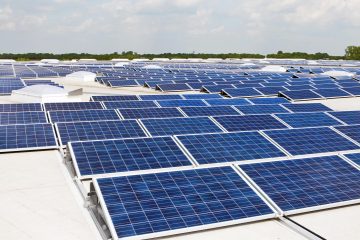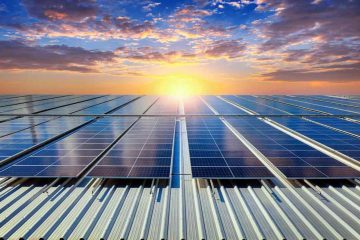As the sun’s rays weave their way through the sky, a silent revolution is taking place on rooftops and landscapes worldwide – the installation of solar panels in series. This innovative approach to harnessing solar energy is not just about capturing sunlight; it’s about creating a connected chain of power that amplifies the benefits of clean, renewable energy. In this article, we delve into the fascinating world of solar panels in series, exploring how this simple yet powerful concept is shaping the way we generate electricity and paving the path towards a more sustainable future. Join us as we unravel the captivating science behind this interconnected solar revolution.
Table of Contents
- Exploring the Benefits of Connecting Solar Panels in Series
- Optimizing Energy Output: Understanding Series Connection in Solar Panels
- Ensuring Safety and Efficiency: Best Practices for Series Wiring of Solar Panels
- Maximizing Performance: Tips for Proper Installation of Solar Panels in Series
- Common Mistakes to Avoid When Connecting Solar Panels in Series
- Q&A
- In Retrospect
Exploring the Benefits of Connecting Solar Panels in Series
When it comes to harnessing solar energy effectively, connecting solar panels in series can offer a range of benefits that are worth exploring. By understanding how this connection method works, you can optimize energy production and increase the efficiency of your solar power system.
One advantage of connecting solar panels in series is the ability to achieve higher voltages, which can be advantageous when charging batteries or powering certain devices. Additionally, this configuration allows for easier maintenance and installation, providing a streamlined approach to managing your solar panel setup.


Optimizing Energy Output: Understanding Series Connection in Solar Panels
When it comes to maximizing the energy output of your solar panel system, understanding how series connections work is crucial. By connecting solar panels in series, you can increase the voltage output while keeping the current constant. This setup is ideal for applications that require higher voltage levels, such as grid-tied solar systems or powering devices that need higher voltages to operate efficiently.
<p>One of the key benefits of using solar panels in series is that it allows for easier system expansion. By adding more panels to the series connection, you can easily scale up your system to meet growing energy demands. Additionally, series connections can help reduce the complexity of wiring, making installation smoother and more organized. Remember to ensure that the panels you connect in series have compatible voltage ratings to prevent any issues with mismatched voltages.</p>

Ensuring Safety and Efficiency: Best Practices for Series Wiring of Solar Panels
When connecting solar panels in series, it’s crucial to follow best practices to ensure both safety and efficiency in your solar power system. One key consideration is to double-check the voltage ratings of each panel to avoid overloading the system. By connecting panels in series, you can increase the total voltage output, propelling your energy production to greater heights without compromising safety.
Moreover, properly securing cable connections between panels is essential to prevent any accidental disconnections, especially in areas prone to strong winds or extreme weather conditions. Regular inspection of the wiring and connections can help detect any issues early on, ensuring the smooth operation of your solar array. By adhering to these best practices, you can optimize the performance of your solar panels while prioritizing safety in your renewable energy setup.
| Best Practice | Importance |
|---|---|
| Check voltage ratings | Prevent overloading |
| Secure cable connections | Prevent accidental disconnections |
| Regular inspection | Early issue detection |


Maximizing Performance: Tips for Proper Installation of Solar Panels in Series
When setting up solar panels in series, attention to detail is key to ensure optimal functionality and maximum energy output. One crucial tip is to carefully inspect each panel for any damage or defects before installation. **By eliminating faulty panels early on, you can prevent potential issues that may impact the overall performance of your solar system.**
Another essential step is to ensure proper spacing between each panel to avoid shading. Shading can significantly reduce the efficiency of your solar array, so positioning panels strategically to maximize sunlight exposure is essential for optimal performance. By following these tips and best practices, you can set up your solar panels in series effectively and harness the full power of solar energy for your needs.
Table showcasing recommended panel spacing:
| Panel Type | Recommended Spacing |
|---|---|
| Monocrystalline | 1.5 times panel height |
| Polycrystalline | 2 times panel height |
| Thin-Film | 3 times panel height |


Common Mistakes to Avoid When Connecting Solar Panels in Series
When connecting solar panels in series, it’s crucial to avoid some common missteps to ensure optimal performance and safety. One mistake to watch out for is mismatched panel voltages, which can lead to inefficiencies in the overall system. Make sure all panels have the same voltage ratings to maintain consistency in power output.
Another common error is improper wiring connections, which can result in reduced energy production and potential safety hazards. Ensure that the positive and negative terminals are correctly connected between each panel to guarantee a smooth flow of electricity. By avoiding these missteps and paying attention to proper installation practices, you can maximize the benefits of connecting solar panels in series effectively.
Q&A
Q&A: Exploring the Power of Solar Panels in Series
Q: What does it mean to connect solar panels in series?
A: Connecting solar panels in series involves linking the positive terminal of one panel to the negative terminal of another. This configuration increases the voltage output while keeping the current constant.
Q: How does connecting solar panels in series impact energy production?
A: By connecting solar panels in series, you can effectively boost the total voltage output of the system. This can be particularly useful when you need to match the voltage requirements of your specific application.
Q: Are there any considerations to keep in mind when connecting solar panels in series?
A: Yes, it’s essential to ensure that the panels have the same current ratings to avoid issues with mismatched power outputs. Additionally, shading on one panel can significantly impact the overall performance of the entire series.
Q: What are the benefits of connecting solar panels in series?
A: One key advantage is the enhanced voltage output, which allows for more efficient energy transfer over long distances or when charging batteries. It also simplifies wiring setups in certain installations.
Q: Can connecting solar panels in series be used in both residential and commercial settings?
A: Yes, connecting solar panels in series is a common practice in both residential and commercial solar installations. It offers a flexible solution for achieving the desired voltage levels based on specific energy needs.
Q: How can I determine if connecting solar panels in series is the right choice for my solar setup?
A: Consulting with a solar energy expert or installer is recommended to evaluate your energy requirements and the feasibility of connecting panels in series. They can assess your needs and provide tailored advice for optimal system performance.
In Retrospect
As you embark on your journey towards harnessing the power of solar energy through series-connected solar panels, remember that each panel is a stepping stone towards a brighter, more sustainable future. The path to clean energy may have its twists and turns, but with every panel aligned in series, you are one step closer to reducing your carbon footprint and embracing a greener tomorrow. Let the radiance of the sun guide you as you string together these solar gems, illuminating not just your home but also the world around you. Together, we can light up the sky with the promise of a cleaner, brighter future for generations to come.




0 Comments